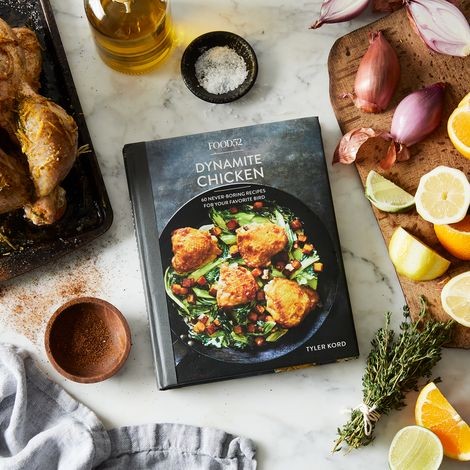Chicken is a versatile and delicious protein, but ensuring it’s cooked to the correct temperature is crucial for both safety and optimal flavor. This guide provides a comprehensive overview of recommended chicken cooking temperatures for various cuts and cooking methods, ensuring juicy, flavorful, and safe-to-eat chicken every time.
 Raw chicken on a cutting board
Raw chicken on a cutting board
Chicken Safety First
Food safety is paramount when preparing chicken. Salmonella is a common concern, and while proper cooking eliminates this risk, preventing cross-contamination is equally important. Use separate cutting boards for raw chicken and other foods, and thoroughly clean all surfaces and utensils after contact with raw chicken.
The official recommendation is to cook chicken to an internal temperature of 165°F (75°C) to instantly pasteurize it, effectively killing any harmful bacteria like Salmonella. While this ensures safety, some argue that certain cuts, especially chicken breasts, can become dry and less palatable at this temperature. An alternative approach is to cook chicken breasts to a slightly lower temperature of around 150°F (65°C) and hold it at that temperature for a few minutes to achieve pasteurization. This method can result in juicier, more tender chicken breasts.
Cooking Temperatures for Different Chicken Cuts
Different chicken cuts have varying fat content and connective tissue, influencing their optimal cooking temperatures and methods.
-
Chicken Breasts: These lean cuts are best cooked quickly to prevent them from drying out. Aim for an internal temperature of 150°F (65°C) to 160°F (71°C) for optimal tenderness. Bone-in breasts may require slightly longer cooking times. Sautéing or poaching are excellent cooking methods for chicken breasts.
-
Chicken Legs (Thighs and Drumsticks): These darker meat cuts benefit from longer cooking times, allowing the fat to render and the connective tissue to break down, resulting in juicy and flavorful meat. Aim for an internal temperature of 175°F (80°C) to 185°F (85°C). Chicken legs are ideal for recipes with longer cooking times, such as braises and stews.
-
Chicken Wings: Known for their high skin-to-meat ratio, wings are perfect for crispy preparations. They can be roasted, fried, or grilled, achieving a delicious char. Aim for an internal temperature of 165°F (75°C), ensuring the meat is cooked through and the skin is crispy.
-
Boneless, Skinless Chicken: Both breast and thigh meat can be used interchangeably in many recipes. Chicken schnitzel works well with breasts, while chicken spiedies benefit from the juicier nature of thighs, especially with long marinades.
Chicken-Cooking Basics: Methods and Temperatures
Here’s a breakdown of popular chicken cooking methods and their recommended temperatures:
-
Whole-Roasted Chicken: Preheat your oven to 400°F (200°C). Season the chicken generously and roast for approximately one hour. Determining doneness can be tricky with a whole chicken. While a thermometer can be used, it’s important to insert it into the thickest part of the thigh without touching the bone. Aim for an internal temperature of 165°F (75°C) in the thigh. Alternatively, check for looseness in the leg joint and skin pulling back from the bone. Let the chicken rest for 10 minutes before carving.
-
Roast Chicken Parts: Similar to roasting a whole chicken, preheat your oven to 400°F (200°C), season the chicken parts, and roast. Breasts should be done in approximately 30 minutes, while legs take around 45 minutes. The meat should be fully white in the middle with no pink.
/0e962076-50f9-4972-827c-80e5e9590632-roasted-chicken-horizontal.jpg)
-
Poached Chicken: This method results in incredibly tender meat. Submerge chicken pieces in water, bring to a light boil, and then simmer gently for 7-10 minutes until cooked through.
-
Sautéed Chicken: For quick and intense caramelization, sauté chicken in a hot pan with oil. Cook skin-side down until almost cooked through, then flip and cook for another minute or two.
-
Broiled Chicken: A fast and aggressive method for achieving crispy skin and tender meat. Keep a close eye on the chicken, flipping it regularly to prevent burning.
-
Shredded Chicken: Poaching and broiling are excellent methods for preparing chicken for shredding. Once cooked, let the chicken cool slightly before using your hands or two forks to shred the meat.
Mastering Chicken Doneness
While thermometers offer the most accurate way to gauge chicken doneness, visual cues can also be helpful. Look for clear juices running from the meat when pierced with a fork (though this isn’t always reliable). The meat should be opaque and firm to the touch, and the leg joint should feel loose.
Experimenting with different cooking methods and temperatures will help you develop a feel for perfectly cooked chicken. Remember that carryover cooking will continue to raise the internal temperature of the chicken by a few degrees after it’s removed from the heat, so it’s best to pull it from the oven or pan just before it reaches the desired temperature.
By following these guidelines, you can consistently cook chicken to the correct temperature, ensuring both safety and deliciousness. Enjoy!
